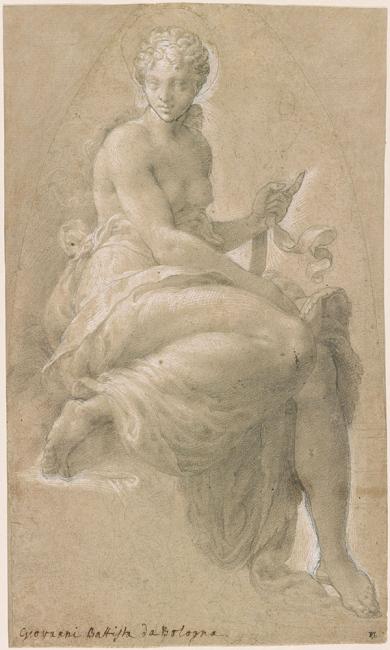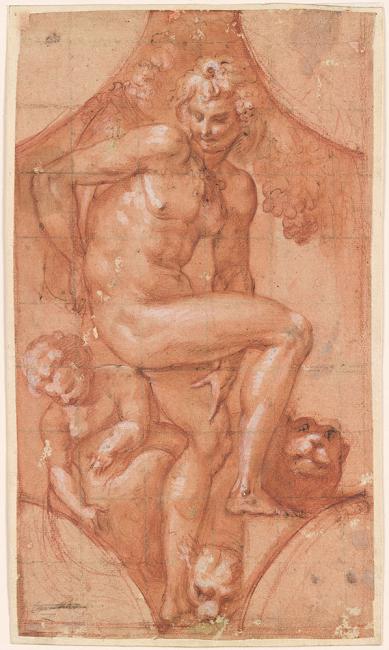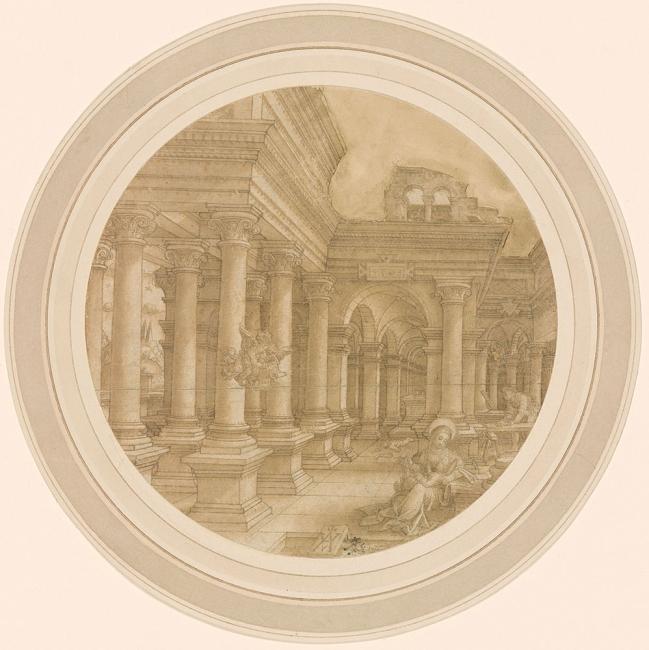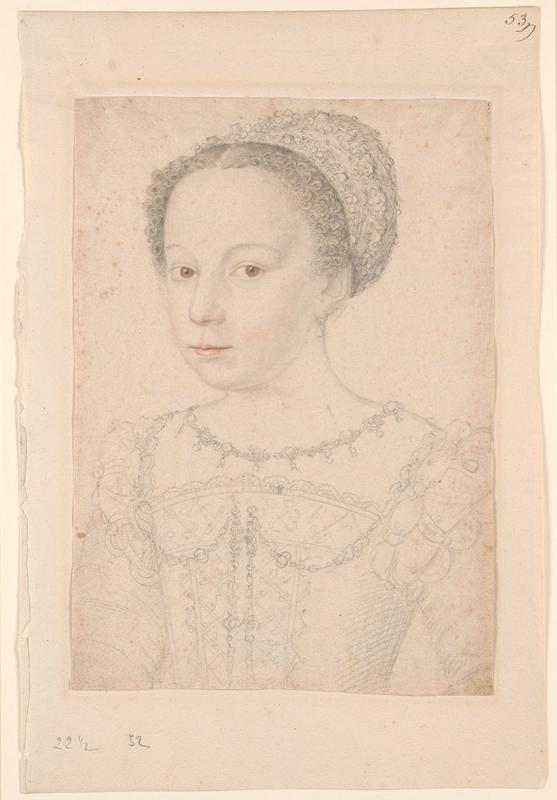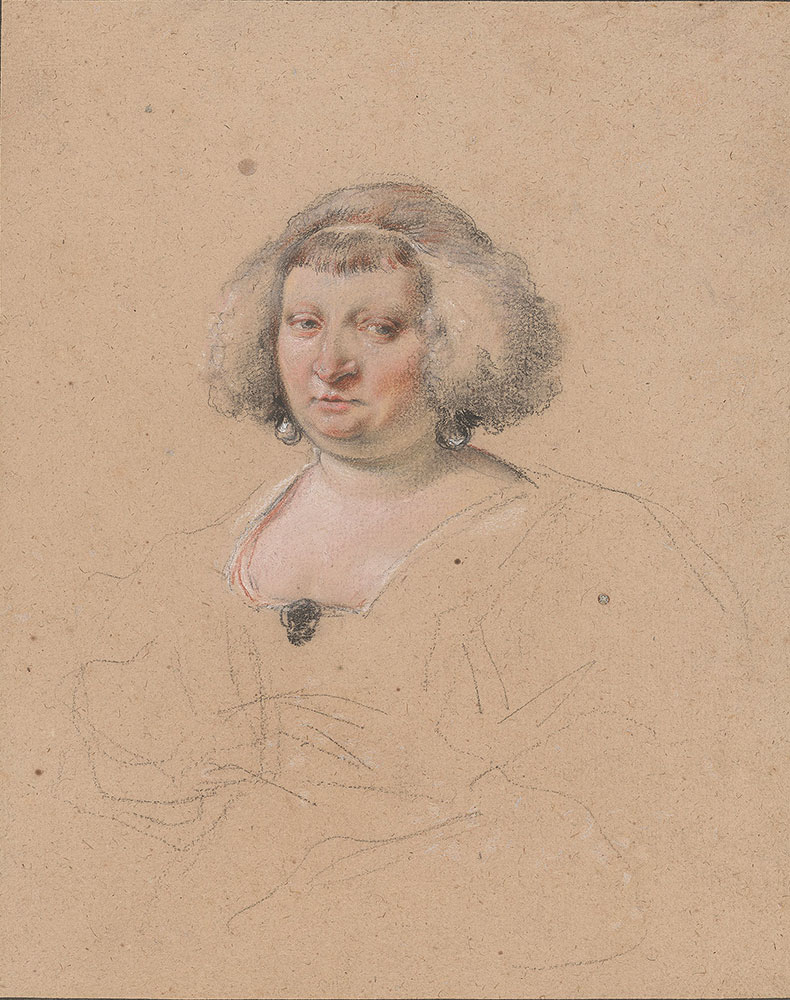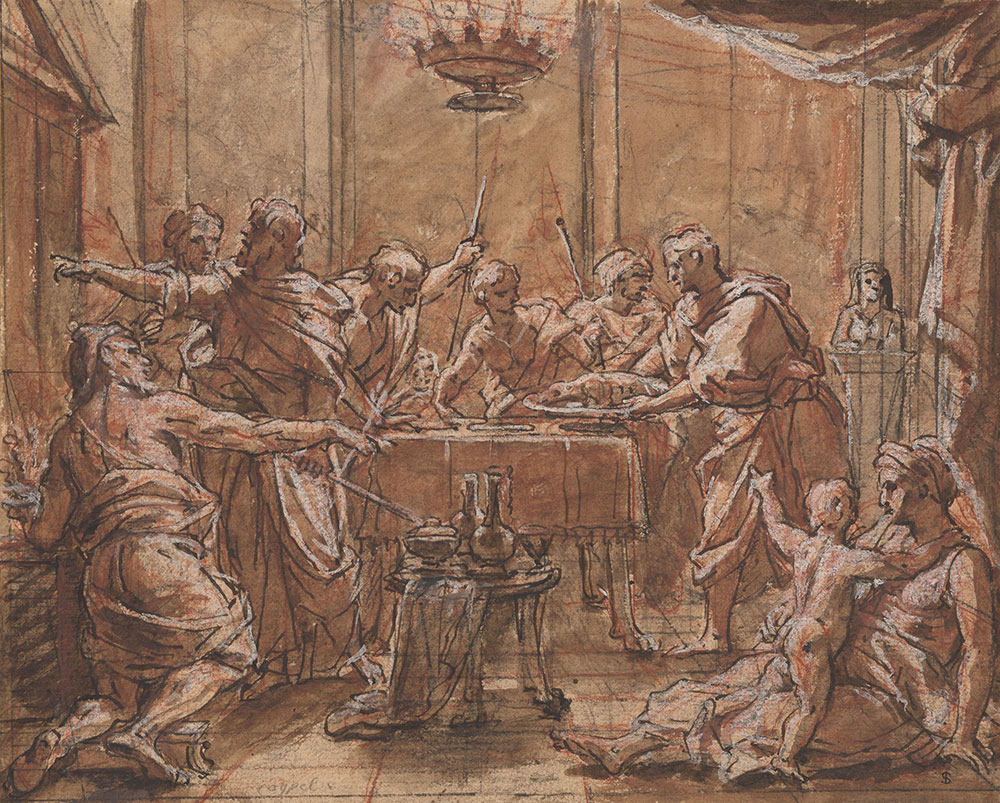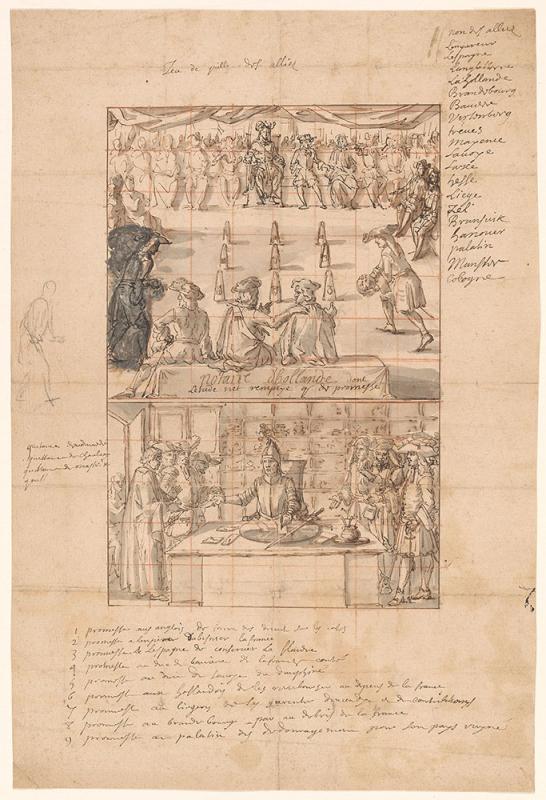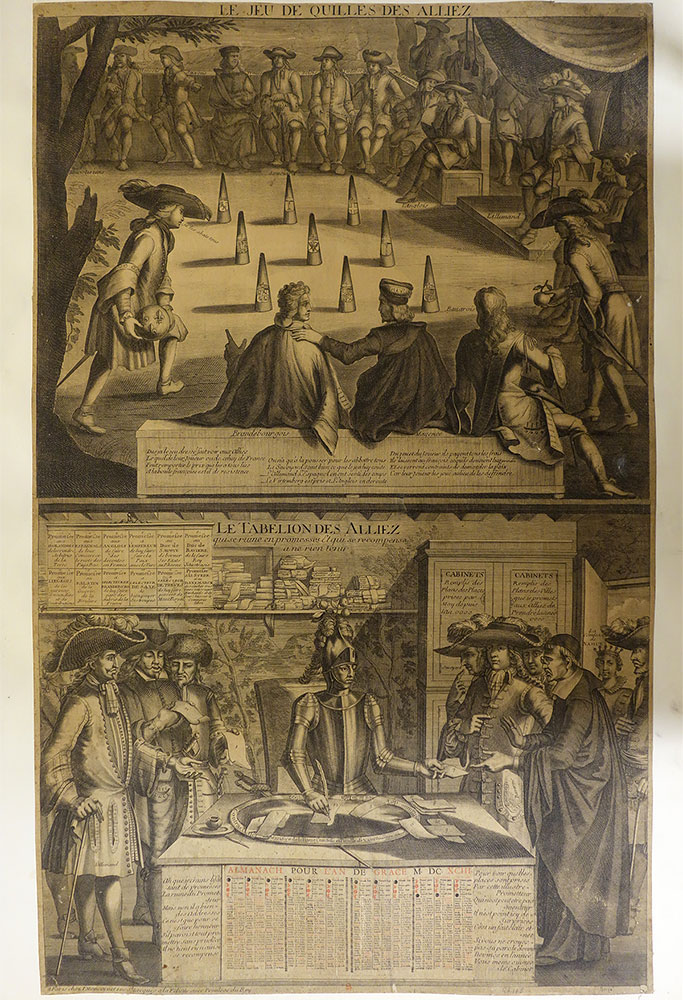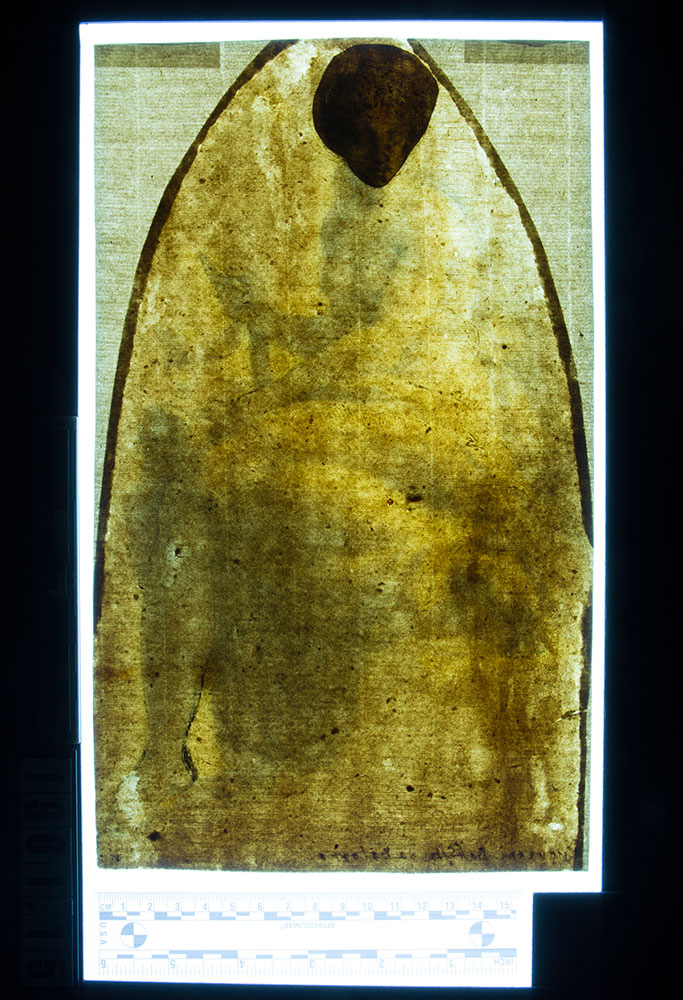Figure of Faith (Figure 1) is one of the Drawing Department’s more enigmatic works. Rendered in soft black chalk with highlights in opaque white added with a brush, it features a seated woman covered in delicate, classical drapery. Upon closer inspection, you can see that strangely, the figure’s head has been cut out and pasted onto the sheet and that the figure was drawn on a sheet that has been trimmed in the shape of an arch and pasted onto a matching sheet of paper. The author of the drawing is also a mystery. In spite of the inscription “Giovanni Battista da Bologna” in the lower left corner, the drawing originally entered the Morgan’s collection as a work from the circle of Francesco Primaticcio (1504–1570). When that attribution could not be upheld, the sheet was relegated to an unknown Italian artist. French scholars, however, have suggested that the work is not Italian at all, but instead by the Paris-born painter Toussaint Dubreuil (ca. 1561–1602), who worked at the French court for Henri IV (1553–1610). The drawing closely resembles one of his works at the Louvre depicting a seated woman surrounded by children who offer her the Crown of Thorns (Inv. 8513).
This mystery drawing was just one of the many examples that were debated during the Morgan Drawing Institute’s recent study day devoted to early French drawings. Bringing together an international coterie of curators, scholars, and graduate students, the event offered an opportunity to discuss problems of historiography, style, and attribution surrounding drawings made in France during the sixteenth and seventeenth centuries.
As the postdoctoral fellow, my charge was to open the day with a discussion of the historiography of the period, that is, the narratives of artistic production created by writers since the seventeenth century, and how these stories have influenced the way we think about the Renaissance in France. In the sixteenth century, French art was international. France had long shared artistic and economic ties with Burgundy, a region in east-central France, and the Low Countries, what is now Belgium and the Netherlands. Works from the early part of the century, such as The Blessed and the Damned, shared a common aesthetic with these northern neighbors. Everything changed with the arrival of Italian Renaissance art and artists, namely Rosso Fiorentino (1495–1540) and Primaticcio, at the court of François I (1494–1547). Their presence dramatically altered the development of French art, and their artistic inventions, including the sensual mythological scenes for which the court became famous, such as this drawing of Bacchus (Figure 2), would dominate French aesthetics for decades to come.
Writing a history of sixteenth-century French art thus became problematic because of the cosmopolitan nature of art production. In the 1650s and 1660s, scholars from the Royal Academy of Painting and Sculpture were swayed by nationalistic pressures to create a distinctly French narrative, one separate from Italy and Italian artists. As a solution, art historians of the seventeenth, eighteenth and nineteenth centuries eulogized French-born Renaissance artists such as Jean Cousin (1500–1593), and Jean and François Clouet (1480–1541 and ca. 1510–1572), as painters of a native school. This nationalistic approach to the art history of the period would continue until the turn of the twentieth century, when the importance of Italian artists would finally be acknowledged. The lack of art historical writing from the sixteenth century has also contributed to the difficulty of studying the period. While Italy produced a number of art historical and theoretical texts, with Giorgio Vasari’s Vite (1568) being the most influential, there are no comparable treatises or histories written by French artists or scholars. This dearth of contemporary accounts has made it harder to understand how French artists approached their practice and to discern the status of drawing in relation to art theory.
Closely associated with the problems surrounding the lack of historical accounts is the issue of style, another important topic addressed during the study day. Given the international nature of France in the sixteenth and seventeenth centuries, scholars still grapple with how to classify drawings made in France. Due to the dominance of figures such as Rosso and Primaticcio at the French court, many works were produced by Italian artists and remain catalogued with the Italian school. Additionally, many scholars still view sixteenth- and early seventeenth-century French art through an Italo-centric lens: since the early twentieth century, art historians have often considered these works only in connection to Italian influences, with less regard for the native Franco-Netherlandish-Burgundian traditions that continued throughout the century.
Thus, the question stands: how can we determine what is a “French” style? The Morgan’s Figure of Faith highlights the complexities of attribution and the similarities between Italian and French drawing styles during the sixteenth century. Additionally, outside of the royal courts at Paris and Fontainebleau (where style was based on an aesthetic determined by the king), different provincial centers such as Lyon developed their own distinct styles, use of media, and taste. During the study day we were joined by Emily Friedman, a Ph.D. candidate from Johns Hopkins University, who shared her research into the intellectual, humanist environment of Lyon and its influence on the drawing and printmaking of Master JG. Curator Jennifer Tonkovich presented a drawing clearly in the Lyon style bearing the monogram “AV” that had yet to be connected to an artist and may be the only known sheet by this obscure master (Figure 3).
The study group next addressed issues related to another dominant genre from this period: portraiture. from the early sixteenth century, portrait drawings in colored chalks were a mainstay of the court and the source of commissions from the French aristocracy. These portraits were highly collectible and often kept in albums; they were also copied over and over for generations, and the Morgan preserves examples after the masters of the genre, Jean and François Clouet (Figure 4). With the advent of the seventeenth century, we see a new interest in depictions of common people that border on caricature, such as the many sheets attributed to the elusive artist known as Lagneau. Our discussion of portraiture encompassed an exciting new acquisition by the Morgan that was presented by John Marciari, the Charles W. Engelhard Curator and Head of Department: a pastel portrait of an elegantly dressed woman (Figure 5) by Simon Vouet (1590–1649). Vouet was a groundbreaking artist who visited Rome and returned to France bringing the lessons of the Italian baroque with him.
For the last part of the day’s program, Jennifer shared some drawings that were the subject of new research and reattribution. During the pandemic, she has spent time carefully reviewing and updating the records for the Morgan’s sixteenth- and seventeenth-century drawings. Among the works that have finally found a convincing attribution is a sheet previously given to Noël Coypel (1628–1707), but now firmly attributed to Guy-Louis Vernansal (1648–1729) based on a related painting in a private collection discovered by Francois Marandet (Figure 6). Francesca Mariano, curator at the Castello Sforzesco in Milan, shared her recent discovery of a drawing by Jacques Stella (1596–1657) for a lost painting, which sheds light on an atypical sheet in the Morgan also attributed to Stella. Ian Hicks, the Morgan’s Moore Curatorial Fellow, presented the results of his investigation into several landscapes associated with Gaspard Dughet (1615–1675).
Despite an extensive research campaign, the authorship of several drawings has remained a mystery. To conclude the session, a selection of these works were shown to crowdsource ideas. Shortly after the program ended, our colleague at the Bibliotheque nationale de France, Vanessa Selbach, had identified an almanach print in their collection for which the Morgan owns the preparatory study (Figures 7 and 8).
Following our study day, we enlisted associate paper conservator Lindsey Tyne to examine the Figure of Faith in the lab to see if closer analysis of the paper, medium and watermark could shed light on the drawing. Using transmitted light (Figure 9), she was able to determine that the drawing consists of three sheets: the main arch-shaped sheet, the paper filling in the upper corners (to make the sheet rectangular in shape), and the small piece pasted directly on top of the arch-shaped sheet (for the head). Conservator Reba Fishman Snyder also examined the Figure of Faith and suggested that the drawing’s rough, light brown paper seems similar to papers used in France. Although there was no watermark to help identify the source of the paper, this examination helped us better understand the strange physical composition of the work and its possible origin. However, many questions remain unanswered. What necessitated the head being redrawn and pasted onto the sheet? Was this a choice by the artist as he was reworking the drawing, or done by a later hand altering the original sheet? Perhaps most importantly, who is the author, and was he French or Italian? Research continues and for now the Figure of Faith remains a tantalizing mystery, highlighting the complexity of French drawings from the sixteenth century.
Jamie Kwan
2020–21 Postdoctoral Fellow at the Morgan Drawing Institute
The Morgan Library & Museum

